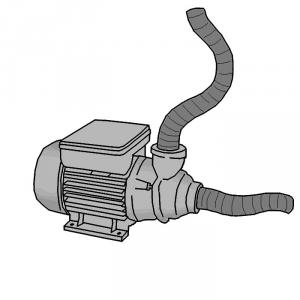المضخات الميكانيكية هي أجهزةٌ لرفع المياه تستخدم لسحب المياه من مصادر المياه السطحية ومصادر المياه الجوفية وخزانات المياه الجوفية ، أو لضخ المياه في أنظمة التوزيع. تعمل هذه المضخات الميكانيكية باستخدام عدة مصادر للطاقة (مثل الكهرباء، والطاقة الشمسية، والوقود، وطاقة الرياح، والحيوانات، والجاذبية). وكعامل مقيِّد، فإن التركيب والتشغيل والصيانة تستهلك لكثير من المال، وتتطلب مستوىً عالٍ من المهارات التقنية وتَوفُّرِ قطع الغيار، والوقود، ومواد التشحيم إلخ. ومع ذلك، فإن معظم المضخات الميكانيكية لديها قدرة أداء عالية، وبالتالي يمكن أن تكون مناسبة ومثالية لنُظُم إمدادات المياه في المناطق الحضرية أوالمناطق الريفية الكبيرة. لذلك، فإن اختيار مصدر الطاقة ونوع المضخة له تأثيرات عديدة ينبغي أخذها في الاعتبار بعناية قبل التنفيذ.
| المُدخلات | المُخرَجات |
|---|---|
المياة العذبة, مياة الشرب |
المياة العذبة, مياة الشرب |
تستخدم أجهزة رفع المياه لرفع المياه إلى ارتفاع يسمح بالوصول المباشر إليها. ويمكن استخدامها لسحب المياه من مصادر المياه السطحية (مثل البحيرات أو الأنهارأو الخزانات )، أو مصادر المياه الجوفية (مثل الآبار المحفورة باليد أو الآبار المحفورة آلياً الخزانات المائية، أو ضخ المياه في انظمة التوزيع ومن الواضح أن أجهزة رفع المياه يمكن أن تخدم كل من الاستخدامات المنزلية ، الصناعات و انظمة الري (مثل الري) . المضخات الميكانيكية (بعكس المضخات التي تعمل بالطاقة البشرية) تعمل بمصادر متنوعة من الطاقة: الكهرباء، والوقود، والحيوانات، وطاقة الرياح، والطاقة الشمسية، والجاذبية. يرتبط مصطلح "المضخات المزودة بمحركات" في الأساس بالمضخات التي تعمل بالديزل والكهرباء.
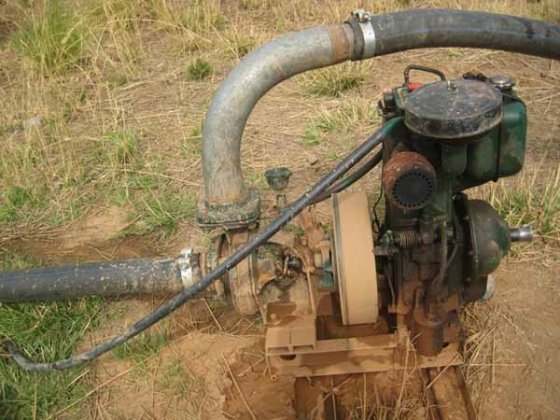
مضخة تعمل بالديزل. المصدر: المعهد الدولي لإدارة المياه (نيويورك IWMI (n.y.)
على الرغم من أن المضخات الميكانيكية قادرة على رفع كميات كبيرة من المياه، إلا أن استخدامها محدود، لأن التركيب والتشغيل والصيانة لمعظم المضخات الميكانيكية يحتاج رأس مال كبير، وتتطلب مستوىً متقدماً من المهارات التقنية وتَوَفُّرِ قطع الغيار، والوقود، ومواد التشحيم إلخ.
بعد اكتساب شعبيةٍ كبيرةٍ في البلدان النامية في السبعينات والثمانينات؛ أظهرت الدراسات أن العديد من المضخات لم يَثبُت استمرارها بسبب نقص الصيانة (ROARK et al. 1989رورك واخرون 1989. (في الآونة الأخيرة، تم الترويج بشكل كبير invalid link كما تم تطوير العديد من التقنيات الجيّدة. ومع ذلك، لا يمكن تجنب استخدام المضخات الميكانيكية لإمداد المياه للمجتمعات الكبيرة، وأنظمة مياه الشرب في المناطق الحضرية وفي الزراعة. على الرغم من ان الشكوك السائدة حالياً حول المضخات الميكانيكية صارت مبررة، ولكن في تلك الحالات فإن استخدامها يمكن أن يكون حلاً جيداً.
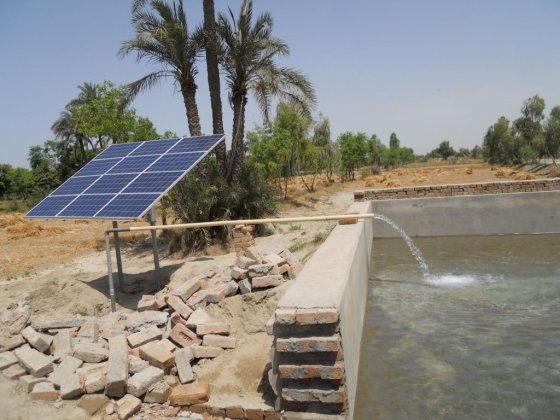
مضخة مياه تعمل بالطاقة الشمسية.المصدر: NE (n.y.)
قد تم تطوير العديد من أنظمة الضخ الميكانيكية المختلفة. نظام الضخ يتكون في الأساس من مضخة وموتور أو ومحرك. وبالتالي، فإن اختيار نظام الضخ يتضمن اختيار نوع المضخة ومصدراً مناسباً للطاقة. على الرغم من أن العديد من أنواع المضخات تتناسب مع مصادر مختلفة للطاقة، إلا أن بعض التراكيب أثبتت فعاليتها أكثر من غيرها.
اختيار المضخة ومصدر الطاقة يعتمد في الأساس على الغرض من الاستخدام (أي: حجم إمدادات مياه الشرب على نطاق متوسط أو كبير او أنها لنظام ري)، وعلى توافر مصادر الطاقة، والوقود وقطع الغيار، وعلى موارد اصيانة
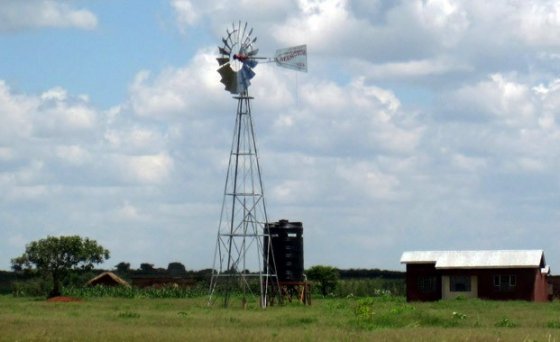
مضخة الرياح والتخزين. المصدر: NSP (n.y.)
تستخدم المضخات في عملها أحد هذه المبادئ، أو تجمع بينها) BAUMANN باومن (2000
• الرفع المباشر: يتم رفع المياه فعلياً (ماديا) في وعاء.
• الإزاحة: المياه غير قابلة للانضغاط، وبالتالي يمكن فقط دفعها أو إزاحتها (التقنية الترددية).
• صناعة ضاغط السرعة: يمكن دفع المياه بسرعات عالية. الزخم الناتج يمكن أن يستخدم إما لعمل ضغط أو تدفق (تقنية الدوران)
وبناءً على هذه المبادئ، تم تصميم العديد من أنواع المضخات المختلفة: المضخات الغاطسة، مضخات الطرد المركزي، المضخات النفاثة ومضخات التجويف التدريجي (احادي) إلخ
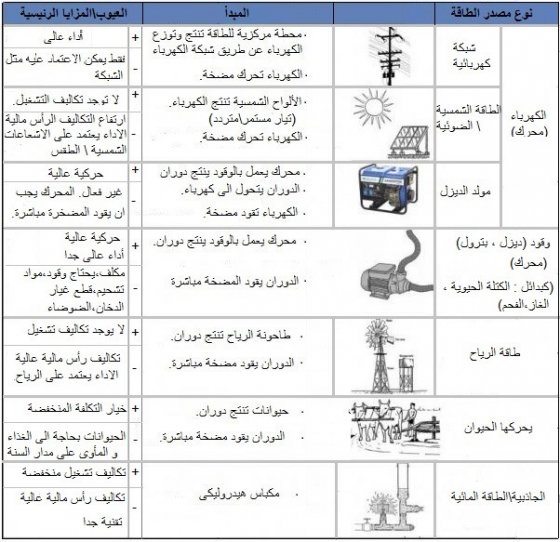
مصادر الطاقة للضخ الميكانيكي. المصدر: M.BRUNI(2012)
تكاليف رأس المال للمضخات الميكانيكية ترتبط أساسا بشراء المضخة، وتركيبها - واعتماداً على النوع- تكلفة الوقود المرتفعه، وقطع الغيار، ومواد التشحيم، والصيانة التقنية. وخلافاً invalid link ، فإن الخيارات قليلة التكلفة للمضخات الميكانيكية بالكاد موجودة.

التكاليف الرأسمالية وتكاليف التشغيل لمصادر الطاقة المختلفة للضخ. المصدر: منظمة الأغذية والزراعة (نيويورك)

مضخة التجويف التدريجي التي يحركها محرك الديزل في إريتريا. المصدر: MONTANEGRO et al. (2010)
تتطلب معظم المضخات الميكانيكية بئراً مغلقاً مع غطاء للتقليل من التلوث السطحي. علاوة على ذلك، فإنّ صيانة البئر بشكلٍ كافٍ و حماية مصدر المياه أمرٌ مطلوب. ومع ذلك، فإنّ المضخات الميكانيكية التي تستخدم الوقود قد تعرّض المياه الجوفية لخطر التلوث. الديزل والبترول وغيره من أنواع الوقود المنسكب على الأرض الغير محمية يمكن ان يتسلل ويتغلغل الى المياه الجوفية مما يسبب تعطيلاً للآبار المحيطة به. كما أن المحركات تنتج أبخرةً وضوضاءَ يمكن أن تكون خطرةً على الأشخاص الذين يعملون على مقربة منها لفترة طويلة.
محركٌ يحركه مصدر طاقة (غير بشرى) يرفع المياه الجوفية من الآبار. | مبدأ العمل |
تحصلان عندما تتوفر الكهرباء بشكل واسع والعمق لا يسمح باستخدام المضخات اليدوية، على سبيل المثال نُظُم الري الكبيرة وإمدادات مياه الشرب في المناطق الحضرية. | القدرة \ الكفاية |
أداء مرتفعٌ جداً إذا تم صيانتها وتشغليها بشكل صحيح. | الأداء |
رأس المال مُكلفٍ بشكل عام، تكاليف التشغيل والصيانة. | التكاليف |
عادة منخفضة نوعا ما إلى معتدلة؛ معدات الإصلاح وقطع الغيار ومواد التشحيم والوقود ضروري/ة. | التوافق مع المساعدة الذاتية |
يعتمد على النظام (نوع المضخة ومصدر الطاقة) | التشغيل والصيانة |
يعتمد على النظام (نوع المضخة ومصدر الطاقة) ومستوى الصيانة. | الموثوقية |
الأداء العالي. | نقطة القوة الرئيسية |
التكاليف العالية. | نقطة الضعف الرئيسية |
في الآونة الأخيرة، تم الترويج بقوة invalid link وقد تطورت العديد من التقنيات الجيدة حتى الآن. مع ذلك بالنسبة لإمدادات المياه لمجتمع كبير وأنظمة مياه الشرب في المناطق الحضرية والزراعة - التي تحتاج الى إمدادات مياه بكفاءة عالية - فإن استخدام المضخات الآلية يمكن أن يكون مناسبا (ROARKواخرون 1889.. المضخات الميكانيكية يمكن أن تكون ملاءمة أكثر من المضخات اليدوية في المناطق التالية:
• المناطق حيث نظام التخزين والتوزيع ضروري (مثل المستشفيات الريفية)، والمناطق الملائمة اقتصاديا (مثل الأحياء الحضرية الفقيرة عالية الكثافة) أو مرغوبةٌ من قبل مجتمعٍ؛ على أن يكون مستعداً وقادراً على دفع تكاليف رأس المال العالية وتكاليف التشغيل والصيانة المرتبطة بمثل هذا النظام.
• المناطق التي يتوفر فيها مصادر للطاقة يمكن الاعتماد عليها وغير مكلفة نسبيا (الكهرباء عادة) وتوافر قطع الغيار والمهارات ومواد التشحيم والوقود.
• لحالات التي تتطلب إنتاجاً أكبر من الإنتاج الذي توفره المضخة اليدوية (مثل المجتمعات التي تملك بئراً واحداً محفوراً وتحتاج المياه لاستخدامات إضافية مثل الماشية والري)
• المناطق التي تكون فيها المياه الجوفية العميقة هي المصدر الوحيد المتاح.
• بعض حالات الطوارئ (مثل التوسع السريع لمخيمات اللاجئين) (UNICEF 1999).
Water Lifting
This comprehensive manual presents different pumps and water lifting techniques and elaborates on technology choice and the role of the institutional framework.
BAUMANN, E. (2000): Water Lifting. (= Series of Manuals on Drinking Water Supply , 7 ). St. Gallen: Swiss Centre for Development Cooperation in Technology and Management (SKAT) URL [Accessed: 08.03.2019] PDFWater Lifting Devices. Irrigation and Drainage Pater 43
Diesel pump in operation
WASH Technology Information Packages – for UNICEF WASH Programme and Supply Personnel
The Technology Information Packages (TIPs) provide technology selection guidelines for UNICEF WASH programme officers and partner organisations. They describe various different technologies and suggest how a programme using these technologies could be implemented.
MONTANEGRO, A. BAUMANN, E. SUTTON, S. ERPF, K. (2010): WASH Technology Information Packages – for UNICEF WASH Programme and Supply Personnel. Copenhagen: UNICEF URL [Accessed: 02.04.2012] PDFSolar Water Pump
Wind mill, pump and storage
Developing Sustainable Community Water Supply Systems. Key Questions for African Development Foundation Applicants
The purpose of this paper is to provide information to groups applying to the African Development Foundation (ADF) about the factors to consider as they design a new community water supply system that will be both sustainable and successful in meeting the established needs of their community.
ROARK, P. YACOOB, M. ROARK, P.D. (1989): Developing Sustainable Community Water Supply Systems. Key Questions for African Development Foundation Applicants. Arlington: Water and Sanitations for Health Project (WASH) URL [Accessed: 07.05.2012] PDFA Water Handbook
The Water Handbook is the result of wide collaboration within UNICEF. It provides a broad overview of state-of-the-art programming for water management, protection and supply.
UNICEF (1999): A Water Handbook. (= Water, Environment and Sanitation Technical Guidelines , 2 ). New York: United Nations Children’s Fund (UNICEF) URL [Accessed: 08.03.2019] PDFﺤﺴﺎﺏ ﻜﻠﻔﺔ ﺇﻨﺸﺎﺀ ﻤﺯﺭﻋﺔ ﺘﺩﺍﺭ ﺒﺎﻟﻁﺎﻗﺔ ﺍﻟﺸﻤﺴﻴﺔ ﻓﻲ ﺍﻟﻤﻨﺎﻁﻕ ﺍﻟﻨﺎﺌﻴﺔ. ﻤﺠﻠﺔ ﺠﺎﻤﻌﺔ ﺩﻤﺸﻕ ﻟﻠﻌﻠﻭﻡ ﺍﻟﺯﺭﺍﻋﻴﺔ , ﺍﻟﻤﺠﻠﺩ (28) , ﺍﻟﻌﺩﺩ 2 , ﺍﻟﺼﻔﺤﺎﺕ ( 431-413).سوريا
Language: Arabic
دليل الطاقة المتجددة وكفاءة الطاقة في الدول العربية .أمانة المجلس الوزاري العربي للكهرباء.إدارة الطاقة, القطاع الأقتصادي . جامعة الدول العربية.القاهرة .جمهورية مصر العربية
Language: Arabic
اﻹﺟــﺮاءات الملموسة التي يجري اتخاذها ﻟﺘﺸـــﺠﻴﻊ ﻣﺼـــﺎدر اﻟﻄﺎﻗـــﺔ الجديدة والمتجددة,بما في ذلك ﺗﻨﻔﻴـﺬ البرنامج العالمي ﻟﻠﻄﺎﻗـﺔ اﻟﺸﻤﺴـﻴﺔ. اﻟﺪورة اﻟﺴﺎدﺳﺔ والخمسون, الجمعية اﻟﻌﺎﻣﺔ.الأمم المتحدة.
Language: Arabic
Linking Technology Choice with Operation and Maintenance in the context of community water supply and sanitation. A reference Document for Planners and Project Staff
This document is addressed to planners and staff of water supply and sanitation projects on household and community level. The reader is guided through the main steps of informed choices regarding the main proven technologies for water supply, purification and water treatment at household and community level. Each technology is described in a small factsheet, regarding its functioning, actors and their roles, the main operation and maintenance (O&M) requirements and problems, which can occur.
BRIKKE, F. BREDERO, M. (2003): Linking Technology Choice with Operation and Maintenance in the context of community water supply and sanitation. A reference Document for Planners and Project Staff. Geneva: World Health Organization and IRC Water and Sanitation Centre URL [Accessed: 03.06.2018] PDFWater Lifting
This comprehensive manual presents different pumps and water lifting techniques and elaborates on technology choice and the role of the institutional framework.
BAUMANN, E. (2000): Water Lifting. (= Series of Manuals on Drinking Water Supply , 7 ). St. Gallen: Swiss Centre for Development Cooperation in Technology and Management (SKAT) URL [Accessed: 08.03.2019] PDFWASH Technology Information Packages – for UNICEF WASH Programme and Supply Personnel
The Technology Information Packages (TIPs) provide technology selection guidelines for UNICEF WASH programme officers and partner organisations. They describe various different technologies and suggest how a programme using these technologies could be implemented.
MONTANEGRO, A. BAUMANN, E. SUTTON, S. ERPF, K. (2010): WASH Technology Information Packages – for UNICEF WASH Programme and Supply Personnel. Copenhagen: UNICEF URL [Accessed: 02.04.2012] PDFHydraulic Ram Pumps
A hydraulic ram pump is an automatic pumping device, which utilises a small fall of water to lift a fraction of the supply flow to a much greater height. This technical brief elaborates on the principle, installation requirements, and the design and performance characteristics of this pump system.
PRACTICAL ACTION (2002): Hydraulic Ram Pumps. Bourton on Dunsmore: Practical Action URL [Accessed: 04.10.2012] PDFSolar Pumping Systems (SPS). Introductory and Feasibility Guide
This guide is intended for local NGO’s and the remote communities they represent, striving to improve the reliability and quality of the community’s drinking water. There are many ways to help a community to improve their drinking water supply. The information in this guide is meant to assist in examining whether or not a solar pumping solution is viable for your particular community.
RATTERMAN, W. COHEN, J. GARWOOD, A. (2007): Solar Pumping Systems (SPS). Introductory and Feasibility Guide. Portland: Green Empowerment URL [Accessed: 08.03.2019] PDFDeveloping Sustainable Community Water Supply Systems. Key Questions for African Development Foundation Applicants
The purpose of this paper is to provide information to groups applying to the African Development Foundation (ADF) about the factors to consider as they design a new community water supply system that will be both sustainable and successful in meeting the established needs of their community.
ROARK, P. YACOOB, M. ROARK, P.D. (1989): Developing Sustainable Community Water Supply Systems. Key Questions for African Development Foundation Applicants. Arlington: Water and Sanitations for Health Project (WASH) URL [Accessed: 07.05.2012] PDFSmall Community Water Supplies: Technology, People and Partnership: Pumping - Chapter 9
This book provides a general introduction to a wide range of technologies. Among the topics covered are: planning and management of small water supplies, community water supplies in Central and Eastern European countries, water quality and quantity, integrated water resources management, artificial recharge, rainwater harvesting, spring water tapping, groundwater withdrawal, water lifting, surface water intake, water treatment, aeration, coagulation and flocculation, sedimentation, multi-stage filtration, desalination technology, disinfection, household level water treatment, technologies for arsenic and iron removal from ground water, and emergency and disaster water supply. Chapter 9: Pumping
SMET, J. ; WIJK, C. van (2002): Small Community Water Supplies: Technology, People and Partnership: Pumping - Chapter 9. The Hague: International Water and Sanitation Centre (IRC) URL [Accessed: 08.03.2019] PDFTools for Assessing the O&M Status of Water Supply and Sanitation in Developing Countries
Problems with the operation and maintenance of water supply and sanitation have long been recognised as key constraints to the sustainability of these services. In order to address these problems in both urban and rural areas of developing countries, this document proposes a framework for management and tools for assessing the status of operation and maintenance (O&M) through measurement and evaluation of performance.
WHO (2000): Tools for Assessing the O&M Status of Water Supply and Sanitation in Developing Countries. Geneva: World Health Organization (WHO) URL [Accessed: 02.04.2012] PDFSocial adoption of groundwater pumping technology and the development of groundwater cultures. Governance at the point of abstraction
This thematic paper examines the historic and ongoing development of water lifting technologies and the governance problems and solutions that have arisen from controlled or uncontrolled groundwater abstraction. It also examines legislation to improved pump efficiency and the economics and life cycle costing of borehole pumps.
FAO GEF IAH IHP World Bank (2012): Social adoption of groundwater pumping technology and the development of groundwater cultures. Governance at the point of abstraction. FAO URL [Accessed: 08.04.2013] PDFFeasibility Assessment for the Replacement of Diesel Water Pumps with Solar Water Pumps. Final Report
A study was commissioned by the Ministry of Mines and Energy (MME) through the Namibian Renewable Energy Programme (NAMREP) to examine the cost effectiveness of solar water pumps compared to diesel water pumps. The study provides an overview of water provision technologies for water supplies in rural Namibia where no piped or open water is available and where the water needs are serviced primarily through boreholes.
EMCON (2006): Feasibility Assessment for the Replacement of Diesel Water Pumps with Solar Water Pumps. Final Report. Windhoek: Ministry of Mines and Energy, Namibia URL [Accessed: 08.03.2019] PDFDisseminating Windpumps in Rural Kenya – Meeting Rural Water Needs using Locally Manufactured Windpumps
Using case studies of wind pump installation projects, the article outlines the challenges facing the dissemination of wind pumps in Africa and the benefits of windpumps to rural and remote areas. Policy options that may improve the dissemination and use of windpumps are proposed.
HARRIES, M. (n.y): Disseminating Windpumps in Rural Kenya – Meeting Rural Water Needs using Locally Manufactured Windpumps. Thika (Kenya): Bob Harries Engineering Limited. URL [Accessed: 08.03.2019] PDFBest Practices in Solar Water Pumping
This documentation provided by the organisation Aurore elaborates on solar pumping methods, lists maintenance tasks and presents short case studies.
AURORE (2002): Best Practices in Solar Water Pumping. Tamil Nadu: Auroville Renewable Energy (AURORE) PDFConsolidation of information. Windpump Handbook
Although not state-of-the-art, this handbook contains much information on 30 different basic types of windmills including technical drawings, tables and graphs.
UNESCO (1982): Consolidation of information. Windpump Handbook. Paris: United Nations Educational, Scientific and Cultural Organisation URL [Accessed: 07.05.2012] PDFWater Portal - Akvopedia
Akvopedia is an open water and sanitation resource. Although the focus is more on sanitation, the water portal section provides many factsheets on different pumping methods and power sources.
Water lifting devices
The Food and Agriculture Organisation of the United Nations (FAO) compiled a very comprehensive publication on water-lifting devices. Its purpose is to provide a basis for comparing and choosing between all present options for lifting irrigation water on small and medium sized land-holdings.
Wind and Water Pump Development and Dissemination Project--Cambodia
Introduction to a windmill development project by the UNDP in Cambodia.



